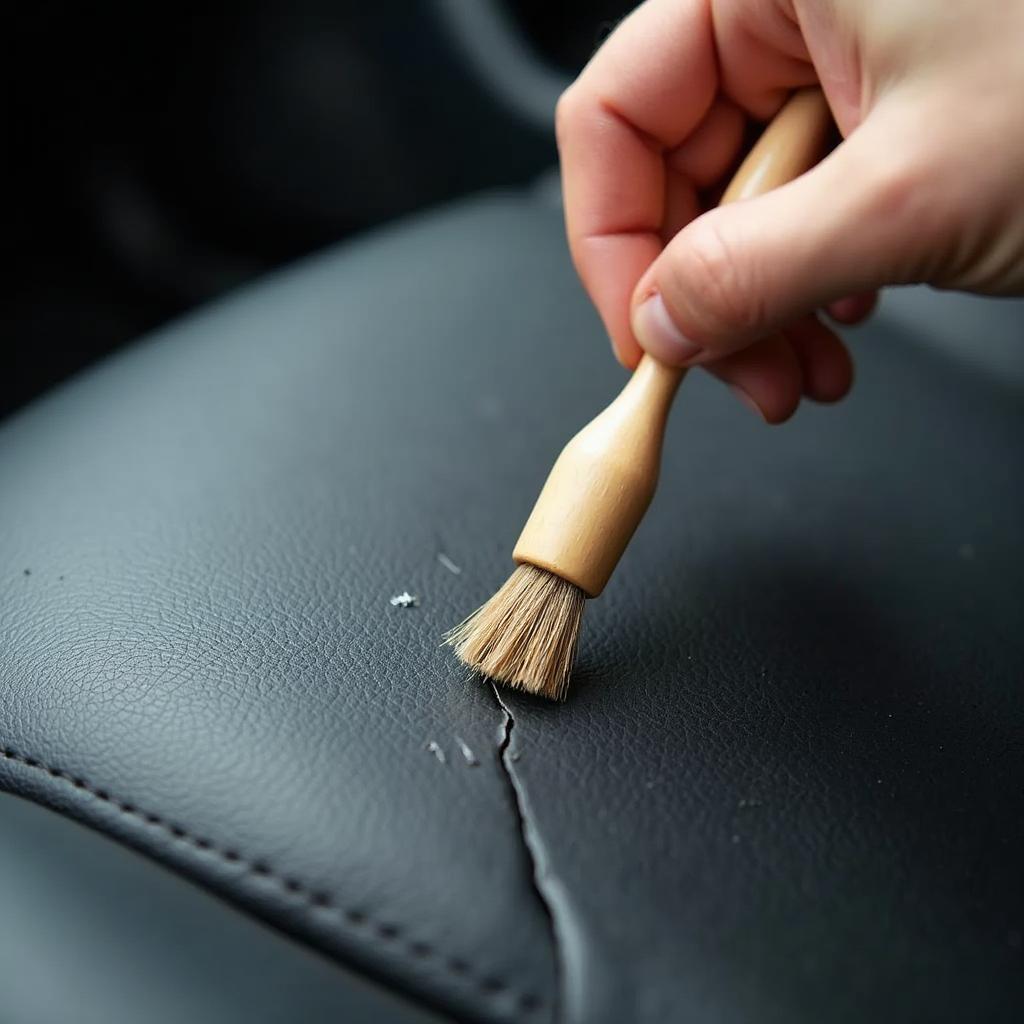Leather car seats are a luxurious addition to any vehicle, but over time, they can crack and show signs of wear and tear. While frustrating, cracked leather car seats are a common problem. Fortunately, you don’t need to spend a fortune on a professional restoration. This guide provides DIY solutions on how to repair leather car seats with cracks and restore their former glory.
Understanding Why Leather Car Seats Crack
Before diving into the repair process, it’s essential to understand the common culprits behind those unsightly cracks.
- Sun Exposure: Prolonged exposure to the sun’s harmful UV rays can dry out the leather, making it more susceptible to cracking.
- Heat: Intense heat, like that inside a parked car on a hot day, can also dehydrate and damage the leather.
- Cold Weather: Extreme cold temperatures can make the leather brittle and prone to cracking, especially if not properly maintained.
- Lack of Conditioning: Leather is a natural material that needs regular conditioning to stay supple. Neglecting this crucial step can lead to dryness and eventual cracking.
- Wear and Tear: Regular use, especially friction from getting in and out of the car, can cause the leather to wear down and crack over time.
 Repairing Cracked Leather Car Seat
Repairing Cracked Leather Car Seat
Gathering Your Leather Repair Arsenal
Before starting the repair process, gather the necessary supplies. Most of these items are readily available online or at your local auto parts store.
- Leather Cleaner: Opt for a dedicated leather cleaner specifically designed to remove dirt, grime, and any previous conditioning products without further drying the leather.
- Leather Repair Kit: These handy kits usually contain a color-matched filler compound, a backing fabric, an application tool, and a colorant to blend the repair seamlessly.
- Leather Conditioner: Invest in a high-quality leather conditioner to moisturize and protect the leather after the repair, preventing future cracks.
- Soft-Bristled Brush: Use this to gently clean the cracks and apply the repair compound.
- Microfiber Cloths: These are essential for wiping away excess cleaner, conditioner, and any residue from the repair process.
- Masking Tape: Protect the surrounding areas of the car seat from accidental spills or smudges.
- Scissors: Use these to cut the backing fabric and any other necessary materials.
- Hair Dryer (Optional): A hairdryer can speed up the drying time of the leather filler compound and the colorant.
How to Repair Cracks in Leather Car Seats: A Step-by-Step Guide
Now that you have your tools ready, follow these detailed steps to repair those pesky cracks in your leather car seats and bring them back to life:
-
Clean the Affected Area: Begin by thoroughly cleaning the cracked area with a leather cleaner and a soft-bristled brush. This will remove any dirt, oils, or debris that could hinder the adhesion of the repair compound. Wipe away the residue with a clean microfiber cloth.
-
Assess the Damage: Once the area is clean and dry, assess the severity of the cracks. For minor cracks, a simple leather filler might suffice. However, deeper cracks might require a repair kit with a backing fabric for added strength.
-
Prepare the Repair Compound: If using a leather repair kit, follow the manufacturer’s instructions for mixing the filler compound. The consistency should be thick enough to fill the cracks but not too thick that it becomes difficult to apply.
-
Apply the Repair Compound: Using the application tool provided in the repair kit or a small putty knife, carefully apply the filler compound to the cracks. Push the compound into the cracks, ensuring they are completely filled. If using a backing fabric, apply it over the filled crack while the compound is still wet.
-
Remove Excess Compound: Use the application tool or a clean edge of a plastic card to remove any excess compound, ensuring a smooth and even surface.
-
Allow Proper Drying Time: Let the repair compound dry completely as per the manufacturer’s instructions. This usually takes a few hours. You can use a hairdryer on a low setting to speed up the drying process, but be careful not to overheat the leather.
-
Sand for a Smooth Finish: Once the compound is completely dry, use fine-grit sandpaper (around 400-grit) to gently sand the repaired area. This will create a smooth and seamless transition between the repaired section and the surrounding leather.
-
Apply Leather Colorant (If Needed): If the repair is noticeable, use a leather colorant that matches your car seat’s color to blend the repair seamlessly. Apply the colorant in thin, even coats, allowing each layer to dry completely before applying the next. You can use a hairdryer on a low setting to accelerate the drying process.
-
Condition the Repaired Area: After the colorant has dried completely (if used), apply a high-quality leather conditioner to the repaired area and the surrounding leather. This will help moisturize and protect the leather, preventing future cracks and fading.
-
Enjoy Your Restored Leather Car Seats: With the repair complete and the leather conditioned, your car seats should look and feel significantly better. Regular cleaning and conditioning will help maintain the repair and keep your leather seats looking their best for years to come.
Prolonging the Life of Your Leather Car Seats: Prevention Tips
Prevention is always better than cure, especially when it comes to leather car seats. Here are some preventative measures to keep your leather looking pristine:
- Regular Cleaning: Dirt and grime are abrasive and can contribute to the deterioration of leather. Regularly clean your seats with a pH-neutral leather cleaner to prevent dirt buildup.
- Consistent Conditioning: Just like our skin, leather needs moisture to stay supple and crack-free. Condition your leather seats every few months, or more frequently if you live in a harsh climate.
- UV Protection: Invest in a sunshade for your windshield or park your car in the shade whenever possible to minimize sun damage. You can also apply a UV protectant spray specifically designed for leather.
- Avoid Extreme Temperatures: As much as possible, avoid parking your car in extremely hot or cold temperatures for extended periods.
Frequently Asked Questions
Q: Can I use super glue to repair cracks in my leather car seats?
A: While it might seem tempting, using super glue is not recommended for repairing leather car seats. Super glue dries rigidly and can worsen the cracks over time, making future repairs more difficult. Additionally, it can create an uneven and unsightly finish on the leather.
Q: How often should I condition my leather car seats?
A: Ideally, condition your leather car seats every three months. However, if you live in a dry climate or frequently expose your car to extreme temperatures, you might need to condition them more often.
Q: Can I repair cat scratches on leather car seats using the same method?
A: While the basic principles of cleaning and conditioning still apply, repairing cat scratches on leather requires a slightly different approach. You might need to use a leather filler to fill in the scratches before conditioning.
Q: Are leather repair kits universal for all types of leather?
A: Not all leather repair kits are created equal. Some kits are specifically designed for certain types of leather, so it’s crucial to choose a kit that’s compatible with the type of leather in your car.
Q: Is it worth repairing cracked leather car seats myself, or should I hire a professional?
A: Repairing minor to moderate cracks in leather car seats is a DIY-friendly project that can save you money. However, if you’re dealing with extensive damage or are uncomfortable with the repair process, it’s best to consult a professional leather repair technician.
Conclusion
Repairing cracks in your leather car seats is achievable with the right tools, techniques, and patience. By following the step-by-step guide outlined above, you can restore your leather car seats to their former glory and prolong their lifespan. Remember, regular cleaning, conditioning, and protection from the elements are key to preventing future cracks and maintaining the luxurious look and feel of your leather interior.
For more comprehensive guides on car maintenance and repair, visit our other helpful resources:
- How to Repair Ford Escape Leather Car Seats With Cracks
- How to Repair Fake Leather Car Seats With Cracks
- How to Repair Cracks in Leather Car Seats
- How to Repair Leather Car Seat Cracks
- How to Repair Cracks in Car Leather Seats
Need personalized assistance with your car repair needs? Contact our team of experts via WhatsApp: +1(641)206-8880, or Email: [email protected]. We’re available 24/7 to provide guidance and support.

